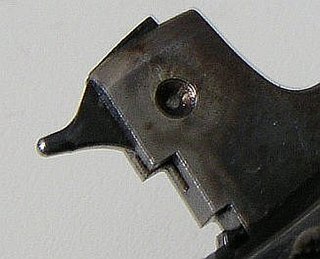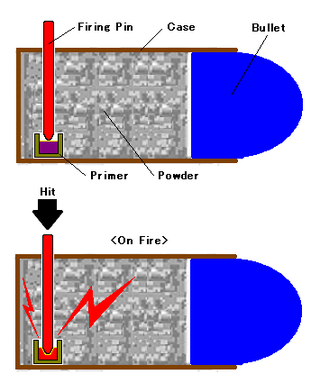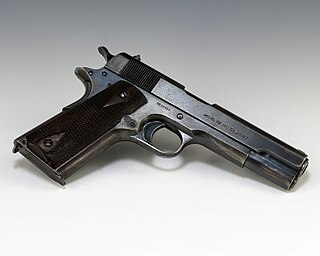
A firearm is any type of gun that uses an explosive charge and is designed to be readily carried and used by an individual. The term is legally defined further in different countries.

In firearm designs, the term single-shot refers to guns that can hold only a single round of ammunition inside and thus must be reloaded manually after every shot. Compared to multi-shot repeating firearms ("repeaters"), single-shot designs have no moving parts other than the trigger, hammer/firing pin or frizzen, and therefore do not need a sizable receiver behind the barrel to accommodate a moving action, making them far less complex and more robust than revolvers or magazine/belt-fed firearms, but also with much slower rates of fire.

The percussion cap or percussion primer, introduced in the early 1820s, is a type of single-use percussion ignition device for muzzle loader firearm locks enabling them to fire reliably in any weather condition. Its invention gave rise to the cap lock mechanism or percussion lock system which used percussion caps struck by the hammer to set off the gunpowder charge in rifles and cap and ball firearms. Any firearm using a caplock mechanism is a percussion gun. Any long gun with a cap-lock mechanism and rifled barrel is a percussion rifle. Cap and ball describes cap-lock firearms discharging a single bore-diameter spherical bullet with each shot.

A cartridge, also known as a round, is a type of pre-assembled firearm ammunition packaging a projectile, a propellant substance and an ignition device (primer) within a metallic, paper, or plastic case that is precisely made to fit within the barrel chamber of a breechloading gun, for convenient transportation and handling during shooting. Although in popular usage the term "bullet" is often used to refer to a complete cartridge, the correct usage only refers to the projectile.

In firearms terminology, an action is the functional mechanism of a breech-loading firearm that handles the ammunition cartridges, or the method by which that mechanism works. Actions are technically not present on muzzleloaders, as all those are single-shot firearms with a closed off breech with the powder and projectile manually loaded from the muzzle. Instead, the muzzleloader ignition mechanism is referred to as the lock.

The pepper-box revolver or simply pepperbox is a multiple-barrel firearm, mostly in the form of a handgun, that has three or more gun barrels in a revolving mechanism. Each barrel holds a single shot, and the shooter can manually rotate the whole barrel assembly to sequentially index each barrel into alignment with the lock or hammer, similar to rotation of a revolver's cylinder.

A breechloader is a firearm in which the user loads the ammunition from the breech end of the barrel, as opposed to a muzzleloader, in which the user loads the ammunition from the (muzzle) end of the barrel.
A repeating rifle is a single-barreled rifle capable of repeated discharges between each ammunition reload. This is typically achieved by having multiple cartridges stored in a magazine and then fed individually into the chamber by a reciprocating bolt, via either a manual or automatic action mechanism, while the act of chambering the round typically also recocks the hammer/striker for the following shot. In common usage, the term "repeating rifle" most often refers specifically to manual repeating rifles, as opposed to self-loading rifles, which use the recoil, gas, or blowback of the previous shot to cycle the action and load the next round, even though all self-loading firearms are technically a subcategory of repeating firearms.

A firing pin or striker is a part of the firing mechanism of a firearm that impacts the primer in the base of a cartridge and causes it to fire. In firearms terminology, a striker is a particular type of firing pin where a compressed spring acts directly on the firing pin to provide the impact force rather than it being struck by a hammer.

A pinfire cartridge is an obsolete type of metallic firearm cartridge in which the priming compound is ignited by striking a small pin which protrudes radially from just above the base of the cartridge. Invented by Frenchman Casimir Lefaucheux in 1832, but not patented until 1835, it was one of the earliest practical designs of a metallic cartridge. Its history is closely associated with the development of the breechloader, which replaced muzzle-loading weapons.

A breechblock is the part of the firearm action that closes the breech of a breech loading weapon before or at the moment of firing. It seals the breech and contains the pressure generated by the ignited propellant. Retracting the breechblock allows the chamber to be loaded with a cartridge.

The lock of a firearm is the mechanism used to initiate firing. It is a historical term, in that it generally refers to such mechanisms used in muzzle-loading and early breech-loading firearms. Side-lock refers to the type of construction, in which the individual components of the mechanism are mounted either side of a single plate. The assembly is then mounted to the stock on the side of the firearm. In modern firearm designs, the mechanism to initiate firing is generally constructed within the frame or receiver of the firearm and is referred to as the firing or trigger mechanism.
Christian Sharps was the inventor of the Sharps rifle, the first commercially successful breech-loading rifle and the Sharps Four Barrel Pistol, and Sharps Breech-Loading Pistol.

A pistol is a type of handgun, characterized by a barrel with an integral chamber. The word "pistol" is derived from the Middle French pistolet, meaning a small gun or knife, and first appeared in the English language c. 1570 when early handguns were produced in Europe. In colloquial usage, the word "pistol" is often used as a generic term to describe any type of handgun, inclusive of revolvers and the pocket-sized derringers.

In firearms, the cylinder is the cylindrical, rotating part of a revolver containing multiple chambers, each of which is capable of holding a single cartridge. The cylinder rotates (revolves) around a central axis in the revolver's action to sequentially align each individual chamber with the barrel bore for repeated firing. Each time the gun is cocked, the cylinder indexes by one chamber. Serving the same function as a rotary magazine, the cylinder stores ammunitions within the revolver and allows it to fire multiple times before needing to reload.
The following are terms related to firearms and ammunition topics.

A multiple-barrel firearm is any type of firearm with more than one gun barrel, usually to increase the rate of fire or hit probability and to reduce barrel erosion or overheating.
A needle gun is a firearm that has a needle-like firing pin, which can pass through the paper cartridge case to strike a percussion cap at the bullet base.
Recoil operation is an operating mechanism used to implement locked-breech autoloading firearms. Recoil operated firearms use the energy of recoil to cycle the action, as opposed to gas operation or blowback operation using the pressure of the propellant gas.

A repeating firearm or repeater is any firearm that is capable of being fired repeatedly before having to be manually reloaded with new ammunition into the firearm.















